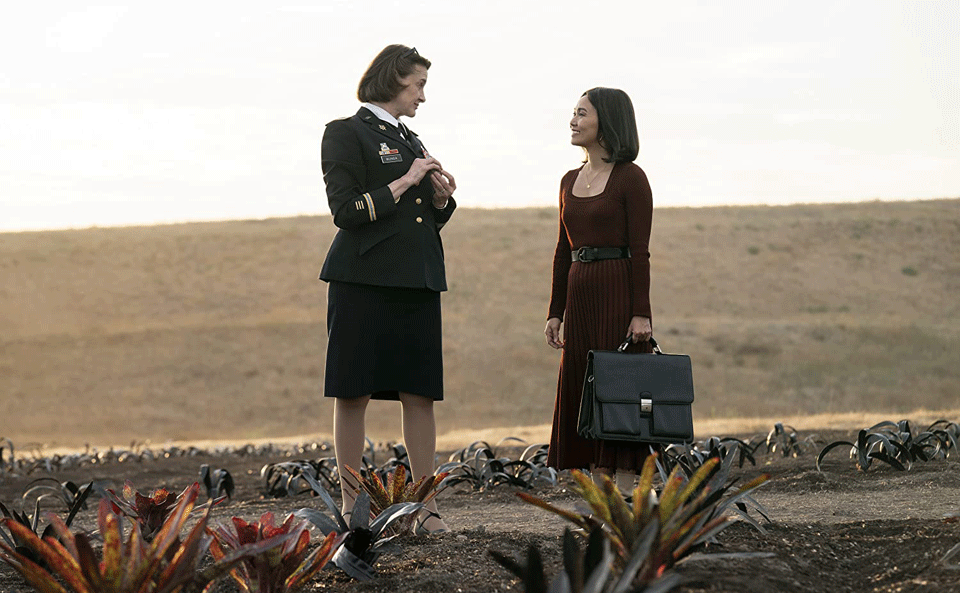
Three new series deal variously with the drug pandemic, that byproduct of the despair that follows in the neoliberal wake. As opportunities shrink because of a global upward redistribution of wealth away from both the working and middle classes and the socially responsible agencies of the state, more people turn to the powerful opioid fentanyl—it’s the old reliable cocaine in both its middle-class (sniffed) and working- and underclass (heated) form as crack—and to newly imagined drugs to remove that pain.
These are the drugs du jour of three series, Hightown, Amo and Homecoming, which deal in various ways with the culture, lifestyle and repressive mechanisms which surround their intake. However, because drugs are useful palliatives in societies that do not welcome change, for the most part the series, while offering detailed descriptions of the problem of drugs, do not offer constructive solutions on how to eradicate them.
Drug dealers in corporate suits: Homecoming
First and foremost is Amazon Prime’s Homecoming, whose second season stars Janelle Monáe (of Harriet, the film about the black abolitionist). The first season had Julia Roberts—in this second season still exec producing—as an at first compliant psychotherapist fronting for a drug and biochemical company, the Geist Group, which used veterans as guinea pigs to test a memory erasing drug. Her mind was wiped also, and she slowly started waking to the callousness of the drug company’s exploitation of humans who were already casualties of the corporate war machine.
The series’ first iteration was as a 20-minute podcast, exceptionally tightly structured, cramming more storytelling into a half hour than more series manage in an hour.
The second season begins with Monáe, also having lost her memory, waking in a rowboat and desperately attempting to piece together who she is and what has happened to her. There is a fractured storyline, somewhat on the order of the film Memento, that when ironed out is actually quite simple. The strength of the second season, though, is its laying bare of the ambition of the Geist Group, which amplifies its first season program of expunging the memories of ex-soldiers to expanding and joining with the military to weaponize its memory-erasing drug to use on the battlefield and on the homefront. The effort is led by Joan Cusack’s Pentagon official whose utter lack of morality or responsibility, couched in corporate-military jargon, is striking.
As the series unfolds, we watch a grab for power by Hong Chou’s put-upon underling who quickly grasps that to get ahead in the biological and pharmaceutical corporate world what is required is an innate ruthlessness and a disregard for how the drugs being developed actually affect the users. She also imbibes a milder form of the drug which the company manufactures, a red roll-on—a “take the red pill and chill”—that allows her to live with the anxiety produced by her lack of conscience.

Fittingly, it is If Beale Street Could Talk’s Stephan James as a vet who doggedly pursues the truth, enacting a karmic revenge on the company that is unfortunately more wish fulfillment than fact, but welcome just the same. It’s a second strong season from one of the few shows to deal with the drug epidemic at one of its sources, which is seldom discussed, the corporate pharmaceutical industry.
High times in Hightown
More problematic by far, but a reliable guilty pleasure, is Starz’ and Amazon Prime’s Hightown, which describes its locale Provincetown, or P-town, as utterly riddled with drugs to the point that only users, sellers, cops and informers inhabit the space. The series focuses on the struggle of a lesbian Latina working-class addict, Jackie Quiñones, who barely holds down her duties on Cape Cod patrolling the coastal waters for illegal catches. Her job is described mockingly by the macho cop she wants to impress as a “fish detective.”

She hits bottom in her addiction early in the series, and we watch her in her twin attempts to get and stay clean and to become an actual detective, a job for which she proves she has an aptitude. Jackie is constantly late on the rent for her disheveled apartment, uses relationships to secure a next high, and sees nothing wrong with her oversexed life in P-town, which she describes to a councilor as a “lesbian Shangri-La.” She finds the body of a young fellow addict and is the first to realize that another young female addict witnessed the murder and is in danger.
The plot cleverly intermixes her struggle to move up in her career with the detritus of her addict life. In tracking a lead on where the witness might be, she has to lie to a former lover to borrow her car and then drive carefully since her license has been suspended. Jackie’s struggle is intermixed with that of the macho cop she is trying to impress, who begins a relationship with the stripper-girlfriend of the drug dealer he is pursing, and an older-brother type fisherman also caught up in dealing and using.
It’s an addictive mix, well illustrating how drugs and drug culture have seeped into every aspect of life in the U.S. and how their use and pursuit propel the young adults in this series and inform every aspect of their existence.
Now the problems. The series is exec-produced by Jerry Bruckheimer, responsible for C.S.I., one of the most conservative of all series on television, where supposedly unerring but actually highly suspect forensic science negated any use for juries or trials, which meant, like Dragnet in the 1950s, the cops were always right.
This is the new, updated Jerry Bruckheimer, but some basic premises remain. The first is that, although treatment centers are a feature of the series, they are largely ruled out as useless and overruled by the need instead for drug use to be policed.
The second is the nature of the villains. The series takes the “daring” tack of having Black and Latinx dealers as its heavies. Daring because Hollywood will usually throw Caucasian dealers in the mix so as not to draw flack. But here we have simply unadulterated racism. The series can point to the prominence of drugs distributed by impoverished communities as an alternative source of income as a rationale for its characterization, but the problem is that the focus stays on the street dealers without any understanding or care to point out the imbrication of a global traffic which also includes the police and is sanctioned if not encouraged by many governments.
Recently, because of Black Lives Matter protests against the police, one of TV’s monuments to racism, Cops, a series that launched Murdoch’s Fox Network and which viewed poor and minority communities entirely from the front seat of a squad car, was cancelled. Hightown has a lot going for it, most especially the engaging struggle of its Latina lead, but it would be nice if it wised up and told some larger truths about how drug culture comes to be and why it is perpetuated instead of sometimes falling back into C.S.I. police supremacist mode.
Drugs and the Duterte death squads
One of the Philippines’ better directors, a global darling of the film festival circuit, is Brillante Mendoza, who of late has taken as his major subject the drug crisis fueled by President Rodrigo Duterte. Like Brazil’s Jair Bolsonaro, Duterte has used the omnipresence of drugs particularly in the slums of Manila as a pretext to wage war against its inhabitants.
Two of Mendoza’s films on the subject present wildly different points of view, and both of these are in evidence in Amo his series for the independent TV5 in the Philippines, distributed globally by Netflix. Ma’ Rosa, a nod to Pasolini’s Ma Roma, details the mom and pop desperation of an elderly couple who must sell drugs in order for their shop to survive and whose family is then brutally beset by the police. Alpha, the Right to Kill, on the other hand, is told almost entirely from the police perspective as we follow a “daring” raid on the heart of the Manila slums that goes wrong. The right of the police to terrorize the populace is affirmed while one lone cop is chastised for corruption. It is most likely that with the success of Alpha Mendoza was commissioned to undertake Amo, a series about a teen drug dealer and his uncle, a corrupt cop.
Why was Mendoza, whose own perspective at times seems to mesh with Duterte’s, chosen to fashion a series on this topic instead of, say, the other well-known Philippine filmmaker Lav Diaz, whose filmmaking style is more oblique but who has proved himself in films like The Halt and The Woman Who Left, a far more strident and nuanced critic of the contemporary regime? Most likely for purely commercial reasons which may also involve government censorship.
Nevertheless, Mendoza is an extraordinary filmmaker incorporating in his series aspects of Neorealism, in his gritty portrayal of the slums, and European Modernism in, for example, a reflexive joke where raps, usually about the desperate situation of the populace, start on the soundtrack and then feature the band themselves as the teenage protagonist walks by them on the street.
Showrunners frequently describe their series as “like a long movie,” but that is seldom the case since they are mostly broken into plot-heavy, bite-size pieces. The style that Mendoza employs, though, using an immediate and intimate hand-held camera and disdaining any kind of explication, easy identification, or judgment of his characters, does make this more like a movie than a series.

The 13 episodes, mostly in Tagalog, the national language of the Philippines, follow first the high school student Amo, or Joseph, as he falls further into the amoral lifestyle of a dealer. He begins by skipping school and employing a young girl as a drug runner to escape a police barricade, and then moves to distributing all kinds of exotic party drugs at a club where, when the drug turns lethal, the English-speaking owners disavow him. He ends alone and on the run. It is in this first half of the series that the Duterte line rules because we watch Amo’s casual corruption turn deadly and contaminate everything he does. This half of the series functions almost as a rationale for tough and lethal police action.
The second half of the series follows Amo’s uncle, a cop himself, as he and his squad carry out a brutal kidnapping of a Japanese drug dealer, coordinated by their superior, the most ruthless of them all. This half functions much more as a criticism of the police and their implication in the overall corruption that the presence of drugs, and the money they generate, produces. And here it is not a lone wolf cop but an entire squad on the force, connected ironically with the Anti-Kidnapping Unit, that plans the kidnapping and subsequent executions.
This is a very mixed series by an extraordinary filmmaker who has brought both his creative talents and his political baggage to television. What the series indicates in actuality is that Philippine filmmakers themselves are not above being corrupted, in this case not by drugs but by the general manipulation of drug culture by those who are not interested in solving the problem but in profiting from it.










